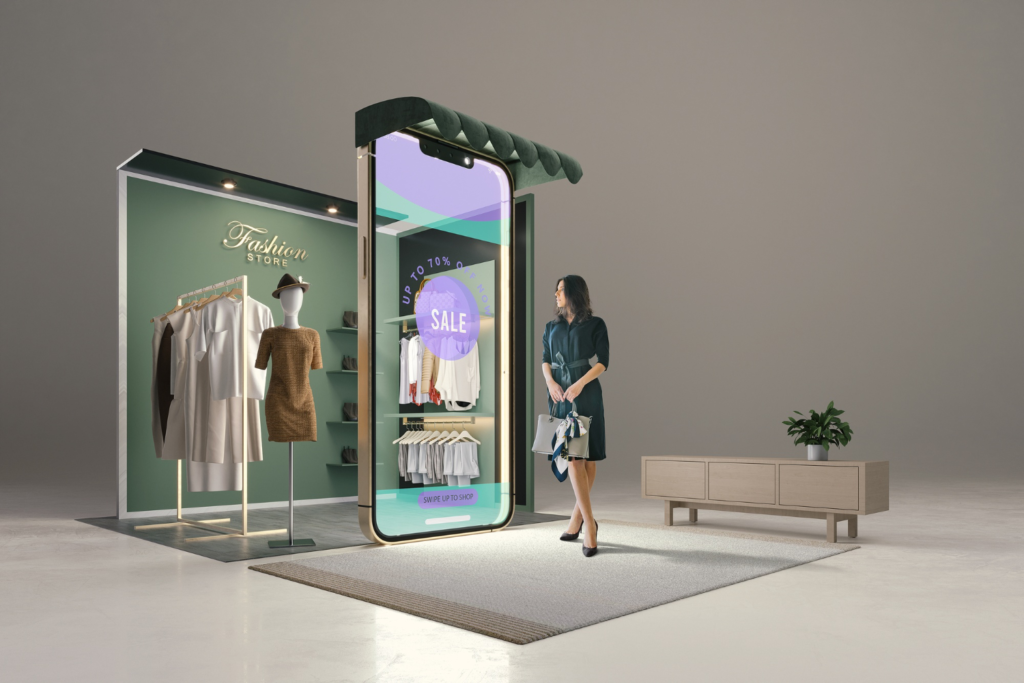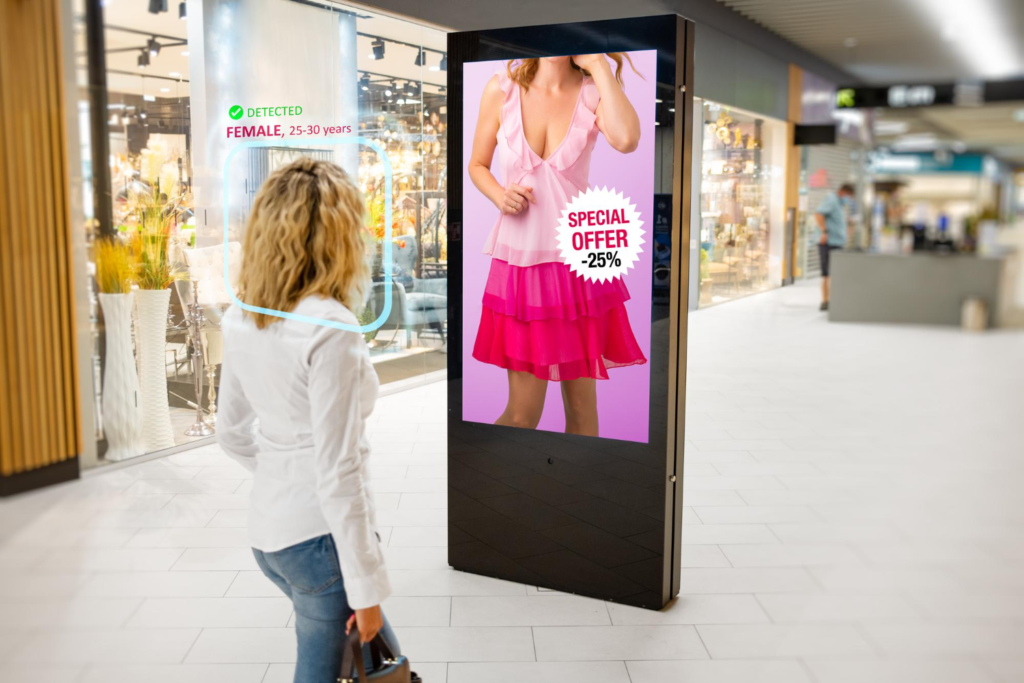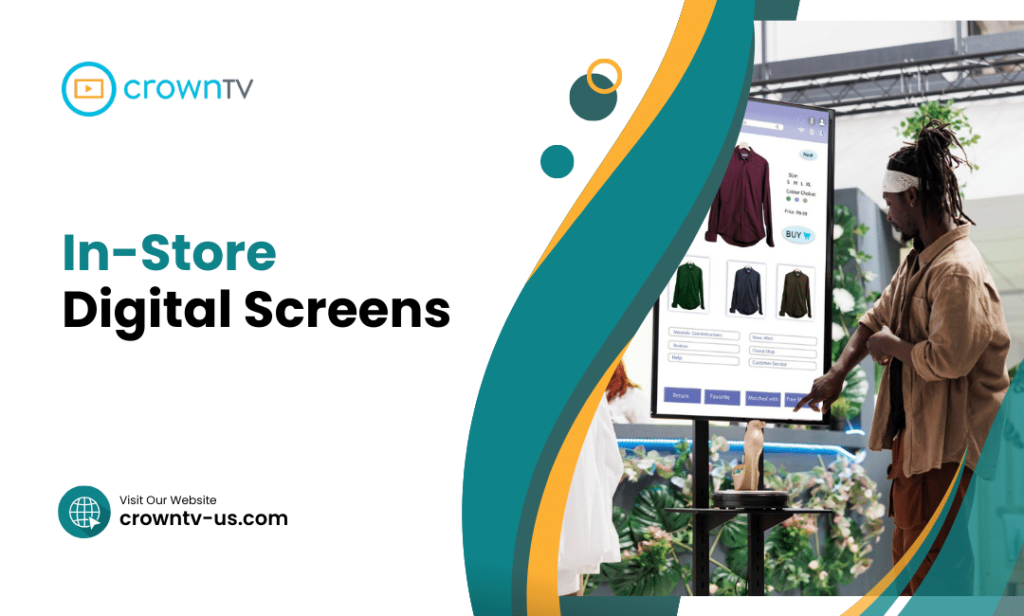In the fast-paced world of retail, staying ahead means embracing the future today. Digital signage is not a trend; it’s a game-changer in how businesses communicate with their customers. This article explores the transformative power of in-store digital screens in retail advertising. We’ll unpack how these dynamic displays are reshaping customer engagement and driving sales.
In this read, you’ll discover:
- The Evolution of Retail Advertising: From Traditional to Digital
- How Digital Signage Enhances Customer Experience
- The Impact of Interactive Screens on Consumer Behavior
- Integrating Digital Signage with Omni-channel Marketing Strategies
- Measuring the ROI of In-Store Digital Screens
Get ready to unlock the potential of digital signage and revolutionize your retail advertising strategy.
The Evolution of Retail Advertising: From Traditional to Digital
Retail advertising has undergone a seismic shift in the last few decades. Gone are the days when static posters and one-size-fits-all marketing messages dominated the shopping experience. Today, we’re witnessing a dynamic transformation as digital signage takes center stage in the retail landscape.
- The Shift from Static to Dynamic: The transition from static to dynamic advertising in retail is like moving from a monochrome TV to a 4K Ultra HD screen. Traditional static ads, while reliable, offered limited engagement, akin to a one-way conversation. In contrast, digital signage is a two-way interactive platform. A study revealed that digital displays capture 400% more views than static displays. This shift isn’t just about catching the eye; it’s about holding attention and creating a dialogue with the customer.
- Personalization and Targeted Messaging: Personalization is the cornerstone of modern retail marketing, and digital signage is at its forefront. According to a report by Accenture, 91% of consumers are more likely to shop with brands that provide relevant offers and recommendations. Digital signage leverages this by using data analytics to deliver targeted messaging. For instance, a screen can display ads based on the time of day, weather, or even specific customer demographics present in the store, ensuring that the content is always relevant and engaging.
- Engagement Through Technology: Digital signage isn’t just a display; it’s a gateway to a world of interactive possibilities. Incorporating technologies like QR codes, touch screens, and NFC (Near Field Communication), these screens invite and engage customers to engage on a deeper level. A survey by Grand View Research noted that the interactive display market is expected to grow significantly, driven by consumer desire for more engaging shopping experiences. This technology turns a simple in-store shopping trip into an interactive journey, enhancing customer satisfaction and loyalty.
- Sustainability and Cost-Effectiveness: The environmental and economic benefits of digital signage are significant. By reducing the reliance on printed materials, businesses can lower their carbon footprint. The U.S. Environmental Protection Agency highlights that digital communication reduces paper waste, a major environmental concern. Additionally, the cost-effectiveness of digital signage is notable. Updating a digital sign is instantaneous and cost-free, unlike traditional methods that incur printing and distribution costs. This efficiency not only saves money but also enables real-time marketing agility.
- The Future is Now: The future of retail advertising is being written today, and digital signage is its author. The global digital signage market is expected to reach $29.8 billion by 2024. It’s clear that this technology is not only one of the passing market trends but a fundamental shift in retail advertising strategy. Retailers who embrace this change are positioning themselves at the forefront of an evolving market, ready to meet the modern consumer’s needs with innovation and efficiency.
As we continue to explore the impact of digital signage in brick-and-mortar stores, it’s evident that this technology is more than just an advertising tool; it’s a transformative element reshaping the retail landscape.
How does Digital Signage Enhance Customer Experience?

Digital signage in retail isn’t just a flashy addition to the store layout; it’s a strategic tool that significantly enhances the customer experience. Let’s break down this impact into three key areas:
Creating Immersive Shopping Environments
Digital signage has the power to transform ordinary retail spaces into immersive, interactive environments. Imagine walking into a store where screens not only display products but also tell a story. For instance, a clothing store could use digital screens to showcase fashion shows or style tips, creating a more engaging shopping atmosphere.
These digital displays can elevate a brand’s image, making it appear more modern and innovative. A study by FedEx Office indicated that 76% of consumers enter a store they’ve never visited before based on its signage. This statistic underscores the importance of visually appealing, dynamic displays in attracting and retaining customer attention.
CrownTV’s media player is engineered to power these seamless digital experiences. We’ve designed this player to be highly reliable and compatible with various formats and screens, ensuring that your content is displayed consistently and without interruptions. This is crucial in maintaining the immersive quality of the digital displays.
Facilitating Informed Purchasing Decisions
Digital signage can provide detailed product information, reviews, and comparisons at the touch of a finger. This level of interactivity supports informed purchasing decisions. For example, electronic stores can use digital screens to compare features of different smartphones, helping customers make better choices based on their needs.
By offering self-service options through interactive kiosks, digital signage empowers customers to explore products independently without feeling pressured. This autonomy not only improves the shopping experience but also increases the likelihood of purchase.
Streamlining the Shopping Journey
Digital signage can be used to entertain and inform customers while they wait, effectively reducing perceived wait times. Screens displaying engaging content in checkout lines or waiting areas keep customers occupied, leading to a more pleasant shopping experience.
Advanced digital signage systems can integrate with customer data to display personalized promotions and guidance. For instance, a customer who frequently buys sports equipment might see targeted ads for new athletic gear or upcoming sales in that category. This level of personalization makes shopping more relevant and enjoyable.
In enhancing the streamlining of the shopping journey, CrownTV’s range of digital signage apps plays a crucial role. These apps extend the functionality of digital signage, making it not just a display tool but a dynamic platform for content delivery and audience engagement. For instance, apps like Instagram and Twitter integration allow for showcasing social media feeds directly on the screens, creating a more connected and contemporary shopping environment.
Additionally, apps like the Weather and Headline News keep customers informed and engaged with real-time updates. This feature is particularly useful in checkout lines or waiting areas, where up-to-date information can provide a distraction, reducing perceived wait times. The ability to display Google Reviews enhances social proof, boosting customer confidence and trust in the brand.
The Impact of Interactive Screens on Consumer Behavior
Interactive screens are more than just digital canvases; they’re powerful tools that actively shape consumer behavior. Let’s delve into six key areas where their impact is most pronounced:
Enhancing Product Visibility
Interactive screens grab attention and significantly boost product visibility. When a new product is featured on a dynamic screen, it naturally draws the eye, encouraging customers to stop and engage. This increased visibility often translates into higher interest and, subsequently, higher sales. As an illustration, a study by Nielsen found that digital signage can increase overall sales volume by up to 32%.
Influencing Impulse Purchases
These screens are particularly effective in influencing impulse purchases. They showcase products in an attractive, interactive manner, tempting customers to make unplanned buys. Imagine a digital screen next to a cosmetics counter showing how different makeup looks can be achieved, enticing customers to try something new.
In the context of influencing impulse purchases, CrownTV’s digital signage dashboard plays a crucial role. This comprehensive software solution allows for seamless content management and real-time device monitoring, which is essential for creating effective and engaging digital displays. The dashboard’s functionality includes:
- One Dashboard, Unlimited Displays: Manage thousands of remote screens easily, as if they were a single display.
- Content Takeover Management: Prioritize content by overriding screens instantly or scheduling takeovers, perfect for highlighting special offers or new products on the digital menu boards that might trigger impulse buys.
- Split-Screen Displays: Show two things simultaneously, like a product advertisement alongside a customer review or a social media feed, enhancing engagement and interest.
- Screen Scheduling: Schedule content for specific times, ensuring that the most enticing and relevant content is displayed at peak shopping hours.
These features enable retailers to create dynamic, attractive displays that capture customer attention and encourage impulse purchases.
Elevating Customer Engagement
Interactive screens offer unique opportunities for customer engagement. They can be used for:
- Interactive marketing campaigns
- Quizzes and games
- Social media integrations
Directly through the screen. This makes the shopping experience more enjoyable and strengthens the brand connection.
Personalizing the Shopping Experience
Advanced interactive screens can tailor content based on customer data, providing a highly personalized shopping experience in sustainable business practices. For example, a screen recommending products based on a customer’s past purchases or browsing history significantly enhances customer satisfaction and loyalty.
Facilitating Decision Making
Interactive screens play a crucial role in helping customers make informed decisions. They provide:
- Detailed product information
- Customer reviews
- Product comparisons
This support is invaluable in guiding customers toward a confident purchase decision.
Gathering Valuable Consumer Insights
Lastly, interactive screens are a goldmine for consumer insights. They track:
- Products customers interact with most
- Time spent engaging with different content
- Types of information that capture interest
This data is crucial for retailers to understand their customers better and tailor their offerings accordingly.
Integrating Digital Signage with Marketing Strategies

In today’s retail landscape, integrating digital signage with omni-channel marketing strategies is not just innovative; it’s essential. Digital signage serves as a crucial touchpoint in the omni-channel experience, seamlessly connecting the online and offline worlds. Retailers leveraging this integration see a cohesive brand message across all channels, enhancing the customer journey at every step.
The true power of digital signage in an omni-channel strategy lies in its ability to provide real-time, consistent messaging that aligns with online campaigns. For example, a promotion advertised on social media can be instantly mirrored on in-store screens, creating a unified marketing message that resonates with customers regardless of how they interact with the brand. This synchronization ensures that the customer receives a consistent experience, whether they’re browsing online or walking through a physical store.
Moreover, digital signage can act as a bridge between the physical and digital realms. QR codes displayed on screens can direct customers to online resources, further blurring the lines between in-store and online shopping. This integration enriches the customer experience and drives cross-channel engagement, encouraging customers to interact with the brand across multiple platforms.
Data plays a pivotal role in this integration. By analyzing customer data from both online and offline interactions, retailers can tailor their digital signage content to reflect the preferences and behaviors of their audience. This targeted approach means that the content displayed on digital screens is highly relevant and engaging, leading to increased customer satisfaction and loyalty.
Measuring the ROI of In-Store Digital Screens
Determining the return on investment (ROI) for in-store digital screens is crucial for retailers to understand the value these tools bring to their business. The process involves assessing various metrics that go beyond mere sales figures, encompassing aspects of customer engagement, brand perception, and operational efficiency.
Sales Volume Increase
- Direct Impact: Assess the increase in sales volume directly attributed to digital signage.
- Before and After: Compare sales data from periods before and after implementing digital screens.
Beyond Sales: Customer Behavior
- Engagement Metrics: Look at dwell time near screens and interaction rates with content.
- Conversion Rates: Analyze the effectiveness of promotions displayed on the screens.
Cost Savings
- Reduced Printing Needs: Digital signage cuts down on the need for traditional printed materials.
- Efficiency in Updates: The ability to update content remotely saves resources.
Customer Feedback and Satisfaction
- Surveys and Feedback: Use these tools to gauge how digital signage affects the overall customer experience.
- Loyalty and Repeat Business: Positive changes in satisfaction often lead to increased loyalty.
Brand Image and Awareness
- Qualitative Impact: Consider the enhanced brand perception and its contribution to foot traffic and new customer acquisition.
Measuring the ROI of in-store digital screens requires a holistic approach. It’s not about sales; it’s about customer engagement, cost savings, satisfaction, and brand impact. By analyzing these metrics, retailers gain a clear understanding of digital signage’s contribution to the retail media networks and their business success, guiding future investments in this transformative technology.
Case Study: Last Call’s Digital Signage Success

In a compelling case study from the fashion retail world, Last Call, an outlet for Neiman Marcus, implemented a strategic test using digital signage to assess its impact on sales. Last Call installed a network of digital screens in key areas of one of its stores, focusing on dresses, shoes, and handbags, appealing to customers preferring formal attire.
This initiative wasn’t just about flashy displays; it was a data-driven approach to understanding the real impact of digital signage on sales and customer behavior.
Sales Impact and Customer Engagement
The results were telling. Detailed sales data, customer traffic patterns, and feedback from sales associates and customers were meticulously analyzed. The use of digital displays allowed Last Call to align its inventory with digital messaging effectively, particularly during peak shopping times. This alignment created a more engaging experience for customers, leading to notable results.
The analytics revealed a substantial increase in the conversion rate for dresses and shoes. However, an initial decline in handbag conversions prompted a deeper analysis. It turned out that handbags were underrepresented in the digital ads, featured in only three of the fifteen advertising clips. This lack of exposure led to customer frustration when in-store inventory didn’t correlate with the images advertised.
The Power of Specificity and Alignment
A key takeaway was the importance of aligning digital content with actual store inventory. For example, when a specific dress was shown on screen, it sold out quickly despite previous below-average sales. This highlighted that customers were not just passively viewing the screens but were actively influenced by specific product images.
Iterative Improvement and Expansion
After adjusting the digital content to represent handbags better and increasing their ad frequency, a second iteration of the pilot was run in the original store and a new store in Dallas, TX. This adjustment led to a positive lift of about 30% in handbag sales. Both dress and shoe sales continued to increase, reinforcing the notion that specific digital ads significantly influenced immediate customer purchases.
This case study underscores the transformative power of digital signage in the retail industry. It’s not just about displaying products; it’s about creating a strategic, data-informed approach that aligns digital advertising with customer expectations and store inventory, leading to measurable sales growth.
The Bottom Line: Transform Your Retail Space with Digital Signage Mastery
As we journey through the evolution and impact of digital signage in retail, it’s clear that this technology is not just a trend but a transformative force. From enhancing product visibility to personalizing the shopping experience, digital signage is reshaping the retail landscape. Here’s a quick recap of what we’ve covered:
- The shift from traditional to digital displays for retail in advertising
- How in-store retail media enhances customer experience
- The profound impact of interactive screens on consumer behavior
- Integrating digital signage with omnichannel marketing strategies
- Measuring the ROI of in-store digital screens
Now, let’s talk about making this digital transformation as smooth as silk. Enter CrownTV’s White Glove Experience. This service isn’t just about installing screens; it’s about crafting a digital signage strategy tailored to your unique business needs. From personalized consultation to expert installation, CrownTV ensures your digital signage journey is seamless, effective, and aligned with your brand’s vision.
Imagine a digital signage retail setup that’s not just installed but optimized for maximum impact and engagement, all handled by experts. That’s the CrownTV promise – sophistication made simple.

